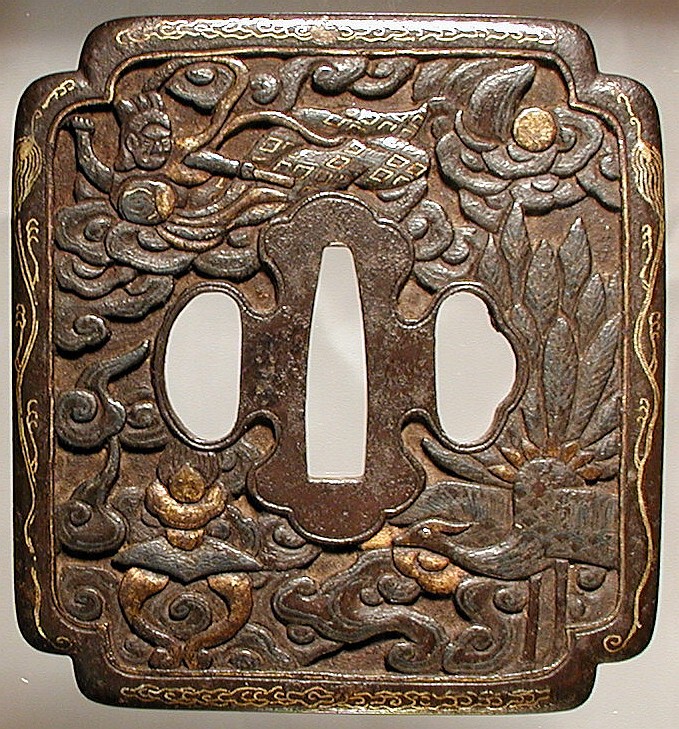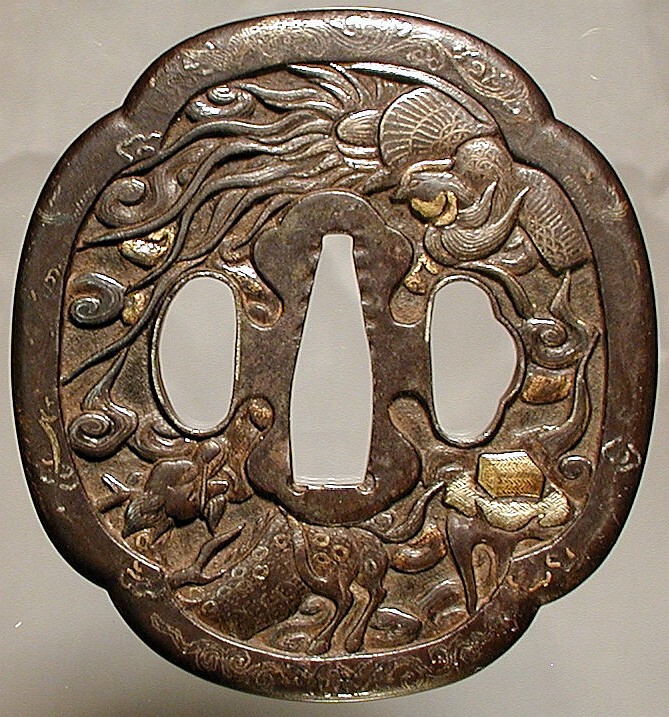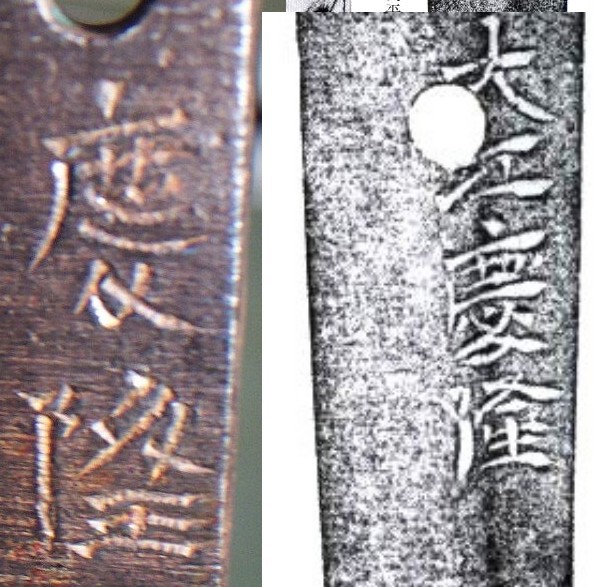-
Posts
703 -
Joined
-
Last visited
-
Days Won
4
Everything posted by Ron STL
-
Brian, looking at the nakago of your Yasuhiro and the placement and overall "feel" of the mei's carving, I'd bet money on this sword being right for shodai Yasuhiro. The hamon also looks as it should for Yasuhiro. Being of the Ishido group, he was copying Bizen hamon in this case which greatly resembles Ichimonji hamon. I would suspect there will be utsuri showing after a 1st class Japanese polish. I once owned a signed Yasuhiro which, if memory is correct, was more of a suguha, but these smiths did both suguha and the Bizen choji style hamon. An interesting mumei (unsigned) katana here (found in mint, high quality naval kai-gunto koshira, mon on menuki, etc.) displays a similar hamon. Before shinsa, it was thought to be shinto, Ishido school work but others felt it was actually Ichimonji. It was finally put through shinsa (Miyano-san) and was papered to Ishido Yasuhiro den. (Most unsigned blades will receive the "den" designation, so it seems.) Anyway, I'll see about attaching some photos of my blade; it's interesting to compare hamon. Ron H.
-
Hi John - This is a confusing area and I agree, Hizen is a safe call. When I first researched this tsuba I went to Fukunaga’s 2-volume set of books, “Hizen no Katana to tsuba," one volume showing tsuba. I was surprised to find an almost identical tsuba as mine signed by a Chinese maker working in Nagasaki. This started my search for more information. I think today, most collectors will call these kind of things Hizen with namban influence. Whether this is correct or not, it gives an accurate tag to the tsuba. Maybe we all try to get too specific in labeling our study pieces when in reality, a lot of it remains simply educated guess-work. Whatever it takes to keep us happy, I say. Ron H.
-
That said, Peter, I'll that the tsuba. :lol: Seriously, iteresting to learn which generation made this tsuba. Ron H.
-
Owning what looks to be a healthy O-suriage naginata-naoshi blade like this would excite me. Being a cut-down naginata as it is, there is a good possibility of this dating into the Nambokucho period (14c) and with some up-close examination -- if quality jigane, nie/nioi hataraki exists -- it would be a wonderful sword to have restored, polished and put into shirasaya. If so, it might be nice to keep the parts and one day reconstruct things, but first things first. The habaki looks in good condition and that could save you the cost of a new habaki if you wish. I really do like the nicely signed Jakushi tsuba as it looks to be a good quality example. A lot of Jakushi work is rather common but when you see one of good quality, personally, I get excited about them! Ron H.
-
Hi John - You asked what my defining characterists were for kagonami tsuba. Most of my information came from “Tsuba, an Aesthetic Study” by Kazuatro Torigoye and Robert E. Haynes, page 239, under Kyūshū District (Hizen). The first paragraph reads, “A type of tsuba to be seen to this day in great quantities was originally made in this area. They are known collectively as Namban tsuba, but this is too broad a term and includes several different types. It is better to divide this single category into sub-categories: Namban, Kanton and Kagonami design styles.” I then wrote that if my understanding was corrected, true Namban tsuba were made outside of Japan and brought into the country by the Portuguese, Dutch, Chinese and Korean. Kanton tsuba on the other hand, were actually made in Japan and copied early Namban (Chinese) works. They are typically of a very symmetrical design. The third sub-category, Kagonami, had a dote-mimi (raised, flattened rims) and instead of having symmetrical motif, they are made asymmetrical, with a more scattered and very busy look to them (as seen in by the tsuba illustrated here). I had to job my memory about all this but it does seem to make sense to have these three sub-categories. Ron H.
-
So-called Namban tsuba have gotten my interest since my as Peter can attest to. (I need to find a copy of Man at Arms and read the article!) A couple years ago I bought a new form of Namban work that was new to me. Then another example was purchased and internet searching put me into contact with an Australia collector who actually collected these. The style of tsuba is called "kagonami," according to what was learned. I'll attach a couple photos of these. I ended up writing an article about kagonami tsuba which appeared in the September 2010 JSS/US Newsletter. It was interesting to realize that Nagasaki was the only entry into Japan for foreigners in the mid-1500s and that was where the Namban (foreign things) were introduced into Japan. I'm sure Peter's article covers all of this quite thoroughly. Ron H.
-

NTHK-NPO SHINSA
Ron STL replied to cabowen's topic in Sword Shows, Events, Community News and Legislation Issues
Oh how I miss those days gone past when we were all young and eager to learn about the swords that turned up around every corner! Learning came hard with little being available in English. Most sword show attendees were young and hungry for information with only a smattering of knowledgeable people -- John Yumoto, Kentaro Yoshikawa, Dean Hartley -- offering their knowledge to us. Today with the Internet we have a wealth of information waiting for us, and that is also good. Look at this site. But things change and some things survive while others do not survive for one reason or another. Today, while sword shows are typically attended by the same familiar faces and few fresh ones, there is some effort to provide study and learning. The NBTHK-American Branch is one such source of learning. It's hard to pay the cost of travel and hotel, meals, bar tabs and last but not least, expensive table rentals...and not want to recoop some funds through sales of items we wish to "move along" from out collections. The best events in recent years, in my opinion, are the ones that Chris and Larry organized in Minneapolis. Bringing a class shinsa team over from Japan headed by Miyano san and then coupling that with a reasonably priced sword show (with full, 8-foot tables, I might add) along with seperate cultural study exhibits and demonstrations, well, it was almost like turning back the clock. Sorry if I'm rambling on too long with this but now I feel better. :lol: Supporting an NTHK-NPO shinsa paired with a purely educational hands-on event but without a sales room? Sadly, I do not think this would ever work in today's economy. I'd love it and would absolutely support it, but I also wish for $1/gallon gasoline, too! Ron H. R -

NTHK-NPO SHINSA
Ron STL replied to cabowen's topic in Sword Shows, Events, Community News and Legislation Issues
The importance of holding a shinsa during a sword show is that the shinsa is a very good draw to a show. Our sword shows are somewhat struggling these days, from what I've been told, and it is important to do whatever is needed to encourage collectors to attend the sword shows. Working together to bring collectors together in both a social and educational atmospher is what we need to be working towards. Just my two cents worth. Ron H. -
The three round curls of hair on the tails I believe help point this work to a school...but which one escapes me at the moment...Somin or maybe Yoshioka??? Ron H.
-
Maru-mune, you sure don't see that very often. Nakago certainly looks naturally aged and that hada is exceptionally bold/vivid, again like koto era. Ron H.
-
Give us a clue where you are located. Maybe there is somebody close to you that can be recommended. Ron H.
-
Naomune...tachi mei...late Heian/early Kamakura??? Got a photo of the nakago? Ron H.
-
No offense, but I'd put this one back in the drawer and feast your eyes on better tsuba. Time better spent. Ron H.
-
I'd be very surprised if this was a shinshin-to sword as the ji-hada looks very "koto" to me, maybe sue-koto. As for those "spots" we are looking at -- I played around with your pictures with contrast, brightness, making it negative (interesting to do that) -- but nothing really jumps out clearly to me. That said, I'd suspect you are seeing tobiyaki or yubashri as Franco thought. Some of these things are quite similar and have subtle differences that change what they are called. How often have we wished for a real expert to be sitting next to us to explain these things to us! (sigh) Ron H.
-
Hi Bill - What an interesting woods find! I never heard of a smith named Keiryu before (nor did I recognize the kanji) which led me into checking further. There is quite a lot written about the smith who used this signature late in life, more commonly known as YoshiHira, in Fujishiro Shin-to hen, p. 109-111 (Harry Watson's translation, pp. 53, 54), an impressive "JoJo saku" rated smith. I was excited about your little tanto, hoping the best for you that is was indeed by this smith. But checking his "late in life" signature illustrated in Fujishiro, the kanji on your tanto seem totally unlike the illustrated example. I shouldn't say "totally" since a few initial features did seem similar, but stroking is quite different. I would say it would be very wise to eventually have a knowledgeable collector check this blade out "in hand" and see what the blades forging/hamon, etc., might tell you about it. I've attached the mei of your discover and the one in Fujishiro...interest comparison! Ron H.
-
Henry, I wonder if this would fall into tachishi work, tachikangushi tsuba ca. Momoyama era thereabout. Often their hitsuana are more odd-shaped than what we see here, but being copper, gold wash, probably relatively thin and the many punchings around the hitsu-ana, that would be my call. Ron H.
-
Hi all - Mid-May, the long-awaited opening of the Samurai Exhibit took place in mid-America Louisville, Kentucky. The JSS/US and NCJSC newsletters have had adverts for this event. I've written a several page pictorial review of the exhibits opening which should be included in both newsletters, soon. The exhibit, which will run through September, is wonderful. It is an exhibit of swords, tosogu and armor but also of cultural items from the Samurai era. There are five rooms of items exhibited with the fifth room being named the "Treasure Room" which has what has been called "the best of the best." A wonderful Masamune, Yoshihiro, Awataguchi Hisakuni, a signed Heian sword that is as fresh as if it was made yesterday. The museum has a catalogue which is highly illustrated and available from the Frazier. The Kokusai Tosogu Kai (KTK)also has many of these items in their 2012 convention catalogue. Only 300 of these catalogues were printed, but they may be found for sale at future sword shows. I hope that anyone who is within travel of the Frazier Museum can take the time to see and study this wonderful exhibition of Samurai treasures. I would be happy to email a copy of my four-page article to anyone interested in receiving it. Just ask. We so seldom have opportunities like this here in the USA, so try to see it. It's time well spent! swords@usroute66.net Ron H.
-
Thanks Matt, I am seeing this pretty well throughout the hamon and would think it prominent enough to note it in a record sheet description. I'll check out that earlier discussion to see what was said. Thanks for the link. The ji-hada is completely hidden by the light scratching that covers the entire blade. Being as new as I think it is, it would be a very tight forging, maybe muji-hada. A polish will expose it in due time. This sword was part of small "lot" I purchased from a friend who needed some funds to replace his car, thanks to a leaping deer! I just sold the wakizashi to a local friend who will eventually have it polished. I just enjoy working up a record sheet to go along with the sword. Always a nice way to study a sword! Ron H.
-
This is a very handsome mumei wakizashi that I would consider shinshin-to. The hamon is very beautiful, what I would call midare-choji with abundant long ashi all along. The boshi is a continuation of the hamon with ko-maru and short kaeri. The hamon definitly slants (saka-ashi). Ubu-ba exists. Nakago is ubu with rounded mune, flat ha. Yasurime are slanting left without the addition of Kesho yarsurime (a little unusual for shinshin-to). If course opinions are welcomed but my real question deals with the hamon description. A very similar hamon is illustrated in Harry's translation of Nihonto Koza (Shinshin-to) p. 266, a sword by Suishinshi Masatsugu. The book simply states "choji midare" but I see abundant patterns of what I'd call "crab claw" pattern along with some "eruptions?" that reach out of the hamon. Yes, I agree with your thoughts...I do sort of beat this kind of thing to death, but it seems a hamon like this needs a better description. Anyone care to have a go at it??? As for my kantei thoughts, I feel it would fall into den Masahide, something into Naotane and with the slanting hamon, perhaps Naokatsu? There is the possibility of this being a Taisho gendai-to or even newer...but I'll stick to shinshin-to for now. The lack of kesho yasurime puzzles me and while the nakago-jiri is ha-agiri it is a little sharp cut on its top portion, sort of resembling Masahide's style but not as obvious. Okay...once again I'm curious how others would describe the hamon and secondly, I thought it would be fun to "kantei" this blade as best as we can through iffy photos! No answer, so we can all be correct! (seems my full length photo is not taking...let's see what turns up...) Ron H.
-
This habaki was on an interesting sword recently brought over for look-see (I forget which sword right now)...but the upper part of the habaki is actually concave. A little hard to see on the picture, but I've never come across a habaki made this way before. Just interesting. Ron H.
-
I saved a couple pics to "My Pictures" and could enlarge them somewhat and adjust contrast. The nakago appears mumei and tells us little from what I can see. The kissaki view shows a rather active hamon that's carried out through the boshi which would make me think "ko-to" work, not shin-to boshi. Can't say much more than that. Most likely another late ko-to wakizashi, ubu but unsigned. Most of these will turn out Bizen den something. (Nakago is not the wide, stubby uchigatana nakago though, you think?) Ron H.
-
Sorry everyone, for my outdated post...I keep forgetting to check the "next" page of posting. Heck, it's 104 degrees today in St. Louis, maybe that got to my aging brain! Ron H.
-
Amazing, that the blade is in such good condition and the nakago so rusted. The tsuka has a family mon or crest on it which is usually a good sign that the sword was carried by someone who might have owned a "better" sword. (My opinion) Nobody has asked, but if you look at the cutting edge under and right in front of the habaki, you might see a "flat" or dulled section. This very often indicates a WWII era blade that has retained this flat area. Not 100% rule, but a good first indicator. I thought with the mei appearing to be close to the mune of the nakago, this might be a good sign since (it seems) most WWII era blades -- Showa-to specifically -- tend to be "signed" down the center of the nakago. Oh yes, the cutting edge length might also be a clue since most of the WWII swords tend to fall into the 25"-26.5" nagasa. Again, not 100% rule but a good indicator for spotting a WWII Showa-to. Funny how the existance of heavy rust on a nakago stimulates our imagination as we try to figure out just what we are looking at! As an aside, I've had several contacts from South Africa over the years and was always fascinated that Japanese swords can be found over there. Eighteen years ago I met a young photographer -- Ivo Muller -- who imigrated from SA and brought his late father's collection of tosogu with him. He turned his many fittings and a blade or two into $$$ for buying camera equipment and we were both happy! Ron H.
-
Looks like a handsome blade, very masculine looking! Which Kanesada this might be...that might be hard to determine being a niji-mei. Could this be sue-koto work? A nice big blade like this with what looks like an active hamon, nice horimono (hi)...would be beautiful, restored. Ron H.
-
I just checked the Meikan and did not see any Hisamichi listed with the title Yamato no kami. I've had this happen before, finding a smith with a title but not recorded in the Meikan. Not sure if that means somebody added this title to the sword or if not all smiths given a specific title have been recorded. The naginata shape does look of the shin-to period. Ron H.













